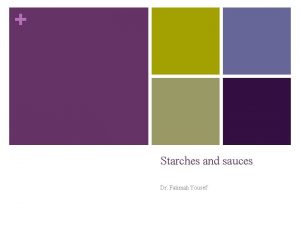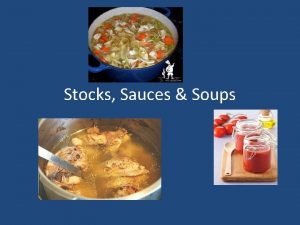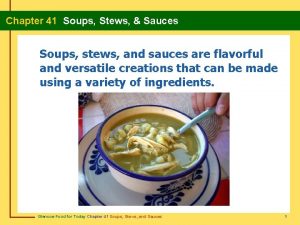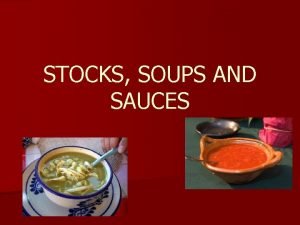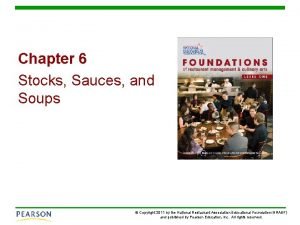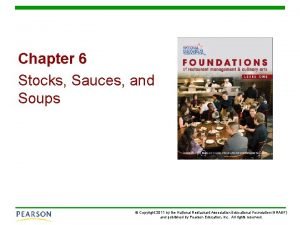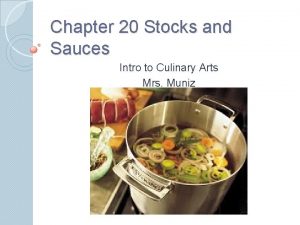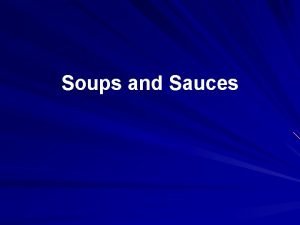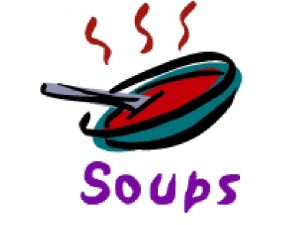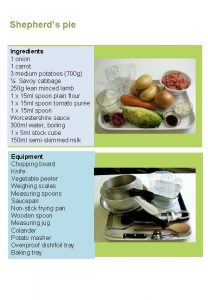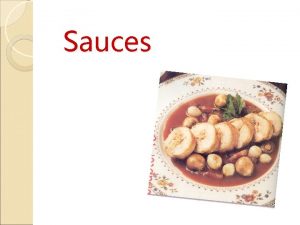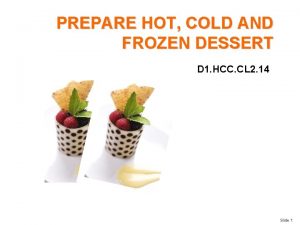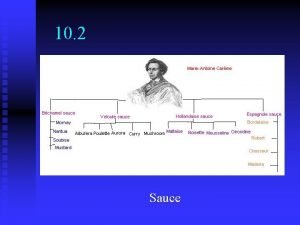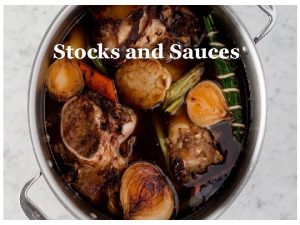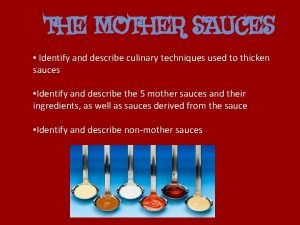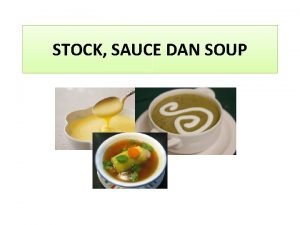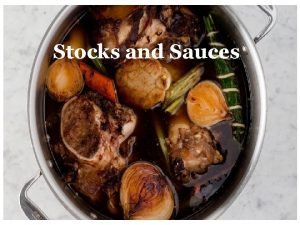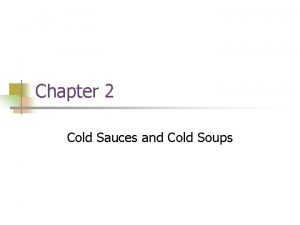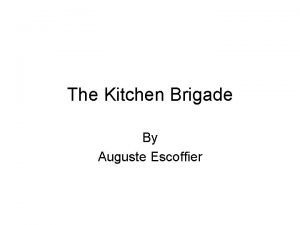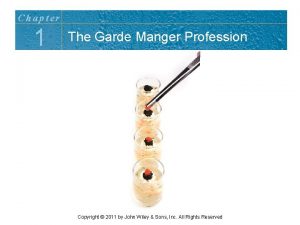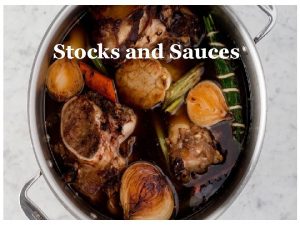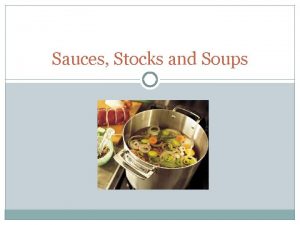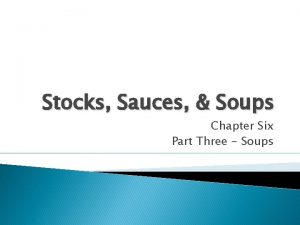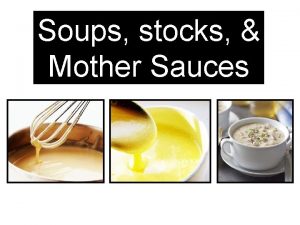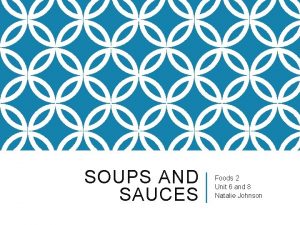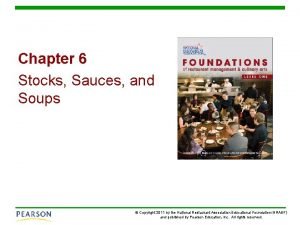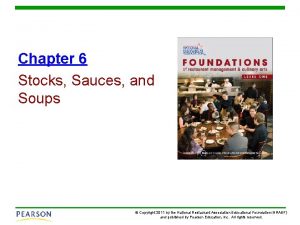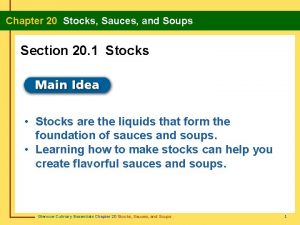Soups and Sauces Chef Michael Moskwa Chef Roger








































- Slides: 40

Soups and Sauces Chef Michael Moskwa Chef Roger Ruch

Sauce • A flavored, thickened liquid used to enhance food. • A good sauce complements the item being served and: • Adds moisture • Adds flavor • Improves appearance • Can enhance texture • Enhance appetite 2

Thickening Agents • • • Flour (as is) Roux Slurry – Cornstarch or Arrowroot Potato or Rice Tapioca Beurre manie Emulsions Reduction Purees / Coulis Final liaison: Cream; egg yolk; whole butter; blood 3

Roux • It is a cooked thickening agent made by combining equal parts by weight (50/50) of clarified fats and flour • Most common thickening agent • Roux is cooked to get rid of floury taste and impart desired color (white; blonde; brown) • The longer a roux is cooked (prior to incorporating into a liquid) the less thickening power it will have 4

Tempering Roux • Roux should be tempered when infused into a liquid. NEVER combine roux and fond of the same temperature. Temper hot to cold or warm to hot. • Liquid must be brought to a boil in order to fully activate starch, then simmered to develop full flavor. 5

Roux Types • Roux Blanc - White Roux: It has the least amount of cooking time, 3 to 5 minutes. No color or aroma. – Béchamel • Roux Blond - Blond Roux: It takes on a tan or golden color and nutty aroma, cook for 5 to 6 minutes. – Velouté • Roux Brun - Brown Roux: Long cooking time if started with untoasted flour, about 15 to 20 minutes (5 to 6 minutes if using toasted flour). It has a deep brown color. – Espagnole 6

Six Qualities of a Sauce • • • Color Opacity Luster Taste Viscosity Texture » C. O. L. T. 7 T. V.

Sauce Qualities • Color: reflects proper selection of stock and thickening agent. Correct color from stock, roux, accessory element, etc. used. • Opacity: the degree of transparency or degree as to which light can pass through the liquid. Reflects the purity of starch involved by selection or refinement through slow cooking. – Transparent: Light passes through sauce (arrowroot, cornstarch, refined starches) – Translucent: Light is lightly diffused (Roux used-flour) – Opaque: Light does not pass through (Béchamel, tomato) • Luster: the shine. Fat contributes. 8

Sauce Qualities – (continued) • Taste: the most important quality. It should compliment the items it is served with. (Salty, sweet, bitter, acidic, savory. ) • Texture: usually smooth, no lumps, which is accomplished by proper incorporation of liaison. Also dépouillage properly and straining. • Viscosity: The thickness or resistance to movement. 9

Specific Leading / Mother Sauces • Béchamel: milk, roux and onion clouted • Velouté: White stock and blond roux • Espagnole: brown stock, brown roux and tomato product – Demi-Glace: Espagnole reduced to perfection • Tomato: tomato product, liquid and seasoning • Hollandaise: eggs yolks, acidified reduction base, clarified butter (warm), lemon juice, seasonings 10

BÉCHAMEL MILK, ROUX BLANC, ONION PIQUET • • 11 Rarely used alone except as a binder. Carefully stir as it will scorch fast Watch the amount of nutmeg used Creamy flavor – No flour taste Off white, NOT gray Very smooth Flavoring and seasoning should be subtle

Béchamel Small Sauces 12

VELOUTÉ - TRANSLATES TO "VELVET" • • 13 Flavor and Aroma reflects the stock used Fond blanc thickened with a blond roux No flour taste Ivory in color (NO HINT OF GRAY) Translucent & Shiny (LUSTROUS) Perfectly smooth texture No graininess

Velouté Small Sauces 14

ESPAGNOLE BROWN STOCK, ROUX BRUN, TOMATO PRODUCT, BACON, MIREPOIX, BOUQUET GARNI • • • 15 Basic brown sauce (DEEP COLOR) Base for some compound sauces Full, rich flavor Seasonings and mirepoix should not be overpowering Full-bodied, not sticky or gluey Translucent to opaque

DEMI-GLACE 50% ESPAGNOLE & 50% BROWN STOCK, BOUQUET GARNI WITH TARRAGON, MADEIRA WINE, REDUCE BY HALF • • • 16 Long cooking time Deep, brown color Rich Flavor High gloss, very smooth, translucent Base for many compound sauces

TOMATO BASE, FLAVORING LIQUID & MIREPOIX • • • 17 Not as many derivatives as the other leading sauces Often used as flavoring component to stews and braises Rich flavor without bitterness / acidity (SAUTÉ ONIONS & GARLIC) Opaque, not overly sweet (CARROTS) Slightly coarser texture than most sauces (TOMATOES)

HOLLANDAISE BUTTER, EGG YOLKS, REDUCTION OR LEMON JUICE, THICKENED BY EMULSIFICATION • • 18 Short holding time, temperature sensitive Cannot be reheated Take care in cooking yolks, they will break Dominant buttery flavor and aroma Should have a luster but not be oily Opaque with smooth texture Light consistency that is pourable

HOLLANDAISE WILL BREAK IF: • • Eggs get too hot (OVERCOOKED) Butter is too warm Butter is added too fast to the egg mixture Sauce gets too cold IF BROKEN, SAUCE MAY BE FIXED • Start with 2 egg yolks • Whisk over water bath until ribbon stage is reached • Add the broken hollandaise to the whisked egg yolks and reform emulsion 19

Compound Sauces • Also called derivative, or small sauces, these are the children of the mother sauces. • They are produced by adding accessory and/or auxiliary elements to the mother sauce 20

Sauce Building Techniques • Determine viscosity • Temper roux • Bring to boil, depouillage (to skim the fat from the top of a sauce), reduce to simmer • Add accessory elements • Simmer until desired quality points are achieved • Strain • Add auxiliary elements and/or final liaison • Season 21

Compound Sauces: Derived from mother / leading sauces with accessory or auxiliary elements added. • ACCESSORY: Element placed in a sauce so as to extract juices and flavor and is then removed by passing the sauce through a strainer. 22 • AUXILIARY: Element is a garnish added to a sauce after it is strained and is a reminder of the origin of the flavor within the dish.

Béchamel Compound Sauces • Cream: Heavy cream • Mornay: Grated parmesan and gruyer cheese • Soubisé: Onion puree and heavy cream • Nantua: Shrimp butter and cream • Raifort: White wine, horseradish and heavy cream 23

Espagnole/Demi-Glace Compound Sauces • Bordelaise: red wine, poached bone marrow • Robert: minced onion, white wine, mustard • Chasseur: shallots, white wine, tomatoes and mushrooms • Diable: shallots, white wine, peppercorns • Madeira: Madeira wine and butter • Bigarade: OJ, vinegar, brandy, Grand Marnier • Forestière: Mushroom essence 24

Tomato Compound Sauces • Portuguese: Onions, tomato concassée, & garlic • Spanish: Diced green pepper and sliced mushrooms • Bolognaise: Ground meat • Creole: Onions, celery, green peppers, & hot sauce 25

Hollandaise Compound Sauces • • • 26 Maltaise: juice of blood oranges Mousseline: whipped heavy cream Royal Glacáge: mousseline with Velouté Béarnaise: tarragon and parsley Choron: béarnaise with tomato Foyot: béarnaise with meat glaze Paloise: mint Rachel: meat glace Grimrod: Saffron

Velouté Compound Sauces • Supreme: heavy cream • Forestière: mushrooms • Allemande: veal Velouté with final liaison of egg and cream • Poulette: Allemande with mushroom essence, lemon and parsley • Bercy: Shallots, white wine, parsley 27

Independent Sauces • These do not use other sauces or a stock as a base. • Often spicy, they include both warm and cold preparations. • Examples of WARM: apple sauce; raisin sauce • Examples of COLD: cranberry; Cumberland, chutney, salsa, relish, cocktail 28

Independent Sauces • Salsa- Raw, diced fruits/vegetables, served with grilled or highly flavored foods. • Relish- Similar to salsa but ingredients are generally pickled in a brine or vinegar. • Chutney- Fruits/vegetables with a sweet and sour component. Most cooked, some raw. • Pesto- “Pounded” Most often with basil (parsley or cilantro) oil, garlic, pine nuts and cheese. • Fruit Sauces- Popular in England US. Accompaniment to roasts / pate. – IE: Cumberland, Mint, Apple, Cranberry 29

Soups Four Categories • Clear • Broth & Consommé • Thin • Thick • Puree, Cream & Velouté • Specialty • Bisques, Chowders, international & Cold 30

Clear Soups • Broth - Liquid result from simmering nourishing element with vegetables and aromatics. Very flavorful. • Consommé - Clarified and fortified soup made from broth or stock with no fat and concentrated taste. 31

Consommé MOP • Clearmeat- lean ground meat, egg whites, mirepoix, tomato, and seasonings. Combine in bowl. • Add clearmeat to cold stock and stir. • Cook over moderate heat; stir often until raft forms, approximately 110*F. • When raft forms stop stirring; reduce heat; simmer gently for 1½ to 2 hours. • Carefully strain consommé through a cheesecloth lined chinois mousseline. 32

Thin Soup • Thin soups use water, stock, or milk as their liquid and include meats, pasta or grains for texture. • Ingredients should complement one another and be visually attractive. – Add when appropriate – Cook grain/pasta separately. 33

Thin Soup Preparation • Sauté, sweat or simmer the solid flavoring elements. • Add broth or stock and seasonings. • Continue to simmer until the desired flavor is achieved. • Dépouillage & Adjust seasonings. • Add in garnish. 34

Thick Soups • Vegetable puree - – Vegetables, legumes, or rice thickeners • Cream - – Singer method (sprinkle flour over the vegetables and fats after they have softened to create a roux) – Addition of cream/milk • Velouté 35 – Sauce which is thinned, garnished,

Puree Soup • Puree – Finely chopped/mashed ingredients • Used as a thickener – Usually done toward the end of cooking – Distinct impact on texture (matte) – Sometimes ½ of the garnish is not pureed for desired texture • Soup often finished with cream 36

Cream Soup • Any soup with the addition of cream or milk • Variations – Velouté finished with heavy cream. – Béchamel based soups. – Singer method: Dust sweated vegetables with flour. Generally finished with heavy cream at end. 37

Specialty Soups Special ingredients or techniques that may reflect regional cuisine. • Bisque- Thick soups usually made from shellfish. • Chowder- Typically contain potatoes, pork or bacon fat, and often shellfish, fish or vegetables. • International- Foreign origin. Examples: Borscht, Miso, Gazpacho, Bouillabaisse. • Cold- May be cooked or uncooked. Vichyssoise is a cold cooked example and Gazpacho or Fruit soup are uncooked examples. 38

Recipes • • Tomato Sauce Bechamel Sauce Mornay Sauce Veloute Sauce Supreme Mango & Roasted Corn Salsa Cream of Chicken Princesse Soup Cream of Carrot Soup For complete recipes, please visit recipes. jwu. edu 39

Student Activities • Study Skills/Group Activities: – Create flashcards with each of the grand sauces or derivative sauces on one side and the list of ingredients on the other. – Make a flowchart of the steps involved in making various sauces. – Create a main dish with an accompanying sauce for a specific event. Create the recipes and then describe why you chose that specific pairing. 40
 Common sources of starch
Common sources of starch Mother sauces names
Mother sauces names Types of mother sauces
Types of mother sauces A flavorful liquid made by gently simmering bones
A flavorful liquid made by gently simmering bones What do soups stews and sauces have in common
What do soups stews and sauces have in common Nminestrone
Nminestrone Chapter 6 stocks sauces and soups
Chapter 6 stocks sauces and soups Chapter 6 stocks sauces and soups
Chapter 6 stocks sauces and soups Bechamel sauce
Bechamel sauce Chapter 6 stocks sauces and soups
Chapter 6 stocks sauces and soups Stanisław młodożeniec moskwa
Stanisław młodożeniec moskwa Moskiewskie metro prezentacja
Moskiewskie metro prezentacja Kamieniarze courbet
Kamieniarze courbet Bronisław malinowski moskwa 1980
Bronisław malinowski moskwa 1980 Classification of thickening agent
Classification of thickening agent Classification of soup
Classification of soup 5 mother sauces recipe and procedure
5 mother sauces recipe and procedure What is the purpose of a sauce? *
What is the purpose of a sauce? * Storing hot and cold desserts
Storing hot and cold desserts Mother sauces and derivatives
Mother sauces and derivatives Stocks and sauces
Stocks and sauces Wringing method cooking
Wringing method cooking Teknik pengolahan kaldu
Teknik pengolahan kaldu Stocks and sauces
Stocks and sauces Cold sauces
Cold sauces Thickened liquids that complement other foods
Thickened liquids that complement other foods 6 types of cold sauces
6 types of cold sauces Chef culinary conference
Chef culinary conference Tourant in kitchen
Tourant in kitchen Define career clusters
Define career clusters Classical brigade system
Classical brigade system Declan hogan chef
Declan hogan chef Famous chef entrepreneurs
Famous chef entrepreneurs Salty brigade
Salty brigade Exposé sur les lions
Exposé sur les lions Garde manger chef definition
Garde manger chef definition Word pattern analogies calculator
Word pattern analogies calculator Analogies examples
Analogies examples Motivation chef de projet
Motivation chef de projet El chef fdf
El chef fdf Bidang sisi yang sejajar dengan bidang dcgh adalah
Bidang sisi yang sejajar dengan bidang dcgh adalah
